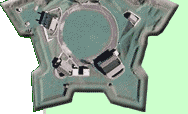
 |
 |
Fort Ticonderoga Ticonderoga, New York |
 |
 |
 |
||||
 |
|||||
 |
Indians first occupied the area where Fort Ticonderoga now stands...although I suppose it's possible that dinosaurs were actually its first inhabitants. French explorer Samuel de Champlain (1580-1635), who would go on to name a lake after himself, was the first European to think nice thoughts about the spot, arriving there in 1609. The first fortification in the location that would become Fort Ticonderoga was Dutch, a small wooden fort built in 1691 at the command of the first mayor of Albany, Pieter Schuyler (1657-1724). The British would go on to take control of the Dutch colony of New Netherland as a result of the Second Anglo-Dutch War (1665-1667), renaming it New York.
The shape of New York state has always reminded me of Donald Duck's head. At least Donald Duck without his hat, which I suppose would make it more like Daffy Duck...regardless, Fort Ticonderoga was built between 1754 and 1757, during the Seven Years' War (1756-1763), by French military engineer Michel Chartier de Lotbiniere (1723-1798)...right smack on the back of Daffy's head, just across the narrows of Lake Champlain from Vermont. The fort was incorrectly named Fort Carillon by the French, who chose the spot to dominate this vital choke point for water traffic through the region. At the time, the area was at the border of the of British New York and French Canada, which meant it was sure to be a flashpoint! Flash this point did on July 8 1758, when a British force of around 16,000 led by General James Abercrombe (1706-1781) attacked Fort Carillon, which was defended by about 4,000 Frenchmen led by General Louis-Joseph de Montcalm (1712-1759). The battle mostly took place about three-quarters of a mile from the fort itself, and featured Abercrombe sending his troops to frontally attack an entrenched enemy, without the benefit of using field artillery to pulverize the French first. This lapse of judgement resulted in a British defeat with some 2,000 casualties, versus around 1,000 on the French side. The Battle of Carillon was France's greatest victory of the war. The British are nothing if not persistent, however. They returned to Fort Carillon on July 26 1759 with a force of 11,000 under General Jefferey Amherst (1717-1797) and placed artillery on nearby high ground, pretty effectively negating any benefit the French may have had from being behind the fort's walls. The officer in command of the fort's small garrison (400 men) was Brigadier General Francois-Charles de Bourlamaque (1716-1764). Bourlemaque didn't bother trying to defend Fort Carillon, but withdrew his force, attempting to blow the fort up on the way: The powder magazine was destroyed, but the British captured the rest of the fort undamaged. The first order of business for the British upon capturing Fort Carillon was to give it a proper name, which fortunately was Fort Ticonderoga. They immediately improved the fort, and started work on a fleet of ships to command Lake Champlain. Once the war was over, however, the fort was allowed to fall in disrepair, and manned by a token force. Before dawn on May 10 1775, Ethan Allen (1738-1789), Benedict Arnold (1741-1801) and the Green Mountain Boys crossed Lake Champlain from the Vermont side and surprised the small British garrison at Fort Ticonderoga. The capture of Fort Ticonderoga proved to be the first American victory of the American Revolutionary War (1775-1783). The fledgeling American army used Fort Ticonderoga as a staging area for an ill-advised invasion of British Canada in July of 1775, which ended up with the British army chasing the American force back to Fort Ticonderoga by October of 1776. Benedict Arnold led a somewhat ramshackle US naval force to defeat against a British naval force under the command of General Guy Carleton (1724-1808) at Valcour Bay on October 11, which nonetheless delayed the British long enough for most of the retreating US army to escape to relative safety. In June of 1777, British General John Burgoyne (1722-1792) led a force of 7800 British and Hessian troops south from Quebec. Burgoyne captured Fort Crown Point without a fight on June 30, then proceeded to do exactly what the British had done in 1759 to relieve the French of their fort: He placed artillery on nearby high ground that the braniac Americans had detemined wasn't worth defending. The commander of Fort Ticonderoga's US garrison, General Arthur St. Clair (1737-1818), ordered his men to run screaming before a shot was fired. Fort Ticonderoga again belonged to the British. A small American force would be sent back towards the fort in September to harass and generally pester the British garrison, but Fort Ticonderoga remained in British hands until November of 1777, when they abandoned both Ticonderoga and Fort Crown Point. |
 |
|||
 |
|
 |
|||
 |
In 2008 the fort's powder magazine, destroyed by the retreating French in 1759, was finally reconstructed! Today, Fort Ticonderoga opens to the public around May 10 of every year, which is the anniversary of its 1775 capture by US forces, and closes in late October. The name Ticonderoga has been given to five different US Navy ships over the years, plus an entire class of both cruisers and aircraft carriers. The Ticonderoga pencil, manufactured by the Dixon Ticonderoga corporation, is also named after the fort. 2021 Update: This page is embarassingly ancient, by 2021 standards...still, I didn't know any better in 2010, and, if I might be so bold, please note that I visited Fort Ticonderoga in August of 2016 (on my birthday!)! Click here to see my visit to Fort Ticonderoga! |
 |
|||
 |
|||||
|
|
|||||||
 |